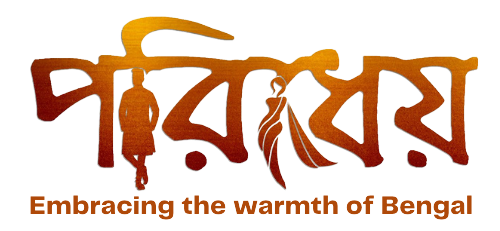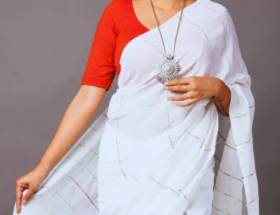Katha Embroidery: Weaving Stories with Needle and Thread
Katha Embroidery, a traditional craft form rooted in the vibrant culture of India, is a testament to the power of storytelling through needle and thread. Artisans bring to life narratives passed down through generations with every stitch they create. This intricate embroidery technique not only reflects the rich heritage of India but also serves as a medium of expression and preservation of age-old tales. In this article, we will delve into the world of hand Embroidery, exploring its history, techniques, significance, and the emotional connection it evokes.
Unveiling the Art of Katha Embroidery
Katha Embroidery, also known as “Katha Bharat,” originated in the state of Gujarat, India. The word “Katha” translates to “story,” and true to its name, this embroidery art form weaves captivating narratives onto fabric. Artisans meticulously create intricate designs by stitching colorful threads onto a base fabric, often using a running stitch or chain stitch technique. The embroidery motifs range from folk tales, mythological stories, and religious narratives to everyday scenes and nature-inspired patterns.
Preserving Traditions and Cultural Heritage
This Embroidery serves as a powerful medium for preserving traditions and cultural heritage. Each embroidered piece carries a piece of history and identity, encapsulating the stories, beliefs, and values of the community. The motifs and patterns used in the Embroidery pass down through generations, keeping the tales and customs alive and vibrant. It is not just embroidery; it is a way of preserving the essence of culture and instilling a sense of pride and belonging.
The Emotional Connection of Katha Embroidery
Katha Embroidery evokes a deep emotional connection both for the artisans creating the pieces and the individuals who admire and wear them. For the artisans, the act of stitching becomes a meditative process, allowing them to channel their creativity and pour their emotions into their work. Each stitch carries the artisan’s passion, skill, and a piece of their soul. For the wearers, these Embroidery pieces hold sentimental value, often becoming heirlooms passed down through generations. These intricately embroidered garments and accessories become a part of one’s identity, evoking a sense of nostalgia and pride.
Techniques and Styles of Katha Embroidery
Katha Embroidery encompasses a wide range of techniques and styles, each with its own charm and beauty. Some of the prominent techniques used in this Embroidery include:
- Running Stitch: The most commonly used stitch in Embroidery is the running stitch.. It involves a simple straight stitch, creating continuous lines and patterns.
- Chain Stitch: Another popular technique used in this Embroidery is the chain stitch. It forms a series of connected loops, resembling a chain. This stitch adds depth and texture to the embroidered motifs.
- Mirror Work: Mirror work, also known as “shisha,” becomes a striking element in this Embroidery. Artisans incorporate small mirrors into the embroidery, reflecting light and infusing the designs with a captivating sparkle.
- Zardozi: Zardozi is a technique that involves the use of metallic threads, beads, and sequins. It adds opulence and grandeur to Katha Embroidery pieces, often seen in wedding attire and festive garments.
The Evolution and Global Recognition
Over the years, Katha Embroidery has evolved and adapted to contemporary trends while staying true to its traditional roots. Artisans have begun experimenting with new color palettes, incorporating modern motifs, and exploring innovative techniques. This evolution has allowed Embroidery to gain recognition not only within India but also on the global stage. Fashion enthusiasts and collectors worldwide now cherish and seek after these Embroidery pieces, appreciating the artistry, craftsmanship, and emotional depth embedded within each stitch.
FAQs
1. What is Katha Embroidery?
Katha Embroidery is a traditional form of embroidery that originated in the Indian state of Gujarat. It is characterized by intricate hand stitching and vibrant colors. The embroidery technique involves using a combination of running stitches, chain stitches, and satin stitches to create elaborate patterns and motifs on the fabric. Artisans often practice Katha Embroidery on textiles such as sarees, dupattas, and home furnishings.
Important information:
- This Embroidery originated in Gujarat, India.
- It is known for its intricate hand stitching and vibrant colors.
- The technique involves running stitches, chain stitches, and satin stitches.
2. What are the motifs used in Katha Embroidery?
This Embroidery presents a diverse array of motifs, drawing inspiration from nature, mythology, and traditional Indian art forms. Common motifs encompass flowers, birds, animals, geometric shapes, and human figures. By combining these elements, artisans craft visually striking and one-of-a-kind designs.
Important information:
- Katha Embroidery motifs are inspired by nature, mythology, and traditional Indian art forms.
- Common motifs include flowers, birds, animals, geometric shapes, and human figures.
- Motifs are combined to create visually stunning designs.
3. What materials are used in Katha Embroidery?
Katha Embroidery uses cotton or silk fabric as the base and cotton or silk threads for stitching. Vibrant and contrasting colors are preferred. The embroidery often includes mirrors, beads, and sequins for added sparkle and texture.
Important information:
This Embroidery utilizes cotton or silk fabric as its base and employs cotton or silk threads for stitching. The embroidery favors vibrant and contrasting colors. Additionally, artisans often incorporate mirrors, beads, and sequins as embellishments.
4. How is Katha Embroidery done?
Katha Embroidery requires skilled artisans to execute intricate stitches and designs entirely by hand. The process starts with fabric and design selection. Artisans transfer the design onto the fabric using tracing or stenciling. They carefully follow the design, using different stitches. After completing the embroidery, they wash the fabric to remove markings or stains before it’s ready to use.
Important information:
Katha Embroidery involves a meticulously handcrafted approach. Artisans transfer the design onto the fabric through tracing or stenciling. They employ various stitches, meticulously adhering to the design. Once the embroidery is complete, the fabric undergoes washing to eliminate any markings or stains.
5. How can one care for Katha Embroidery?
To maintain the beauty and longevity of Katha Embroidery, proper care is vital. Hand washing the garments with mild detergent and cold water is recommended. Avoid soaking the embroidery for an extended period. Gently squeeze out excess water and lay the garment flat to dry, away from direct sunlight. Iron the garment on the reverse side using a low heat setting. Avoid hanging Katha Embroidered textiles as it may cause the fabric to stretch or distort.
Important information:
- Hand washes Katha Embroidered garments with mild detergent and cold water.
- Avoid soaking and hang drying.
- Iron on the reverse side using low heat.
Conclusion
Katha Embroidery transcends being a mere craft; it becomes a storytelling medium, preserving traditions and eliciting emotions. With every thread interwoven, artisans breathe life into cherished narratives passed down through generations. The intricate stitches, vibrant colors, and delicate embellishments reflect the cultural richness of India and the artistic prowess of its artisans. Katha Embroidery pieces hold within them stories of love, heritage, and a shared connection to the past. So, the next time you adorn yourself with a Katha Embroidery creation, remember that you are carrying a piece of history, woven with emotions and the magic of storytelling.






